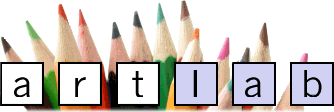|
See davidgauntlett.com for new stuff. |
 |
![]()
|
This page contains
articles, and material from talks and events, about the ArtLab methods and approach.
See also the page of individual projects. |
 |
|
R
E C E N T F E A T U R E S : |
||
| Young people's mediaworlds: process videos | A two-year
research project (2008-10) using creative methods to explore how young people make sense of, and participate in, their complex media environments. A series of videos show our progress with this project. Funded by the AHRC. |
|
| Visual methods discussion | On 27 July 2007 the website of the UK's Visual Methods training network (funded by the ESRC) hosted an online discussion between David Gauntlett and some other members of the network. | |
| Fatimah Awan's PhD thesis | Project which explored young people's perceptions of their own identities by inviting them to create identity collages that expressed 'how I see myself' and 'how I think other people see me'. | |
| Ross Horsley's PhD thesis | Project which explored notions of masculinity by asking young men to create a front cover, and a contents page, for an imaginary men's magazine. | |
| Sebastian's identity globe | Sebastian May created a 3D model of his identity for a student project. | |
| Lego research slideshow | Online slideshow explaining our work with Lego Serious Play. | |
| Visual Studies interview | Creative and visual methods for exploring identities: A conversation between David Gauntlett and Peter Holzwarth, published in the journal Visual Studies in 2006 (abridged version) | |
| E V E N T S : |
||
| Transforming Audiences | Transforming Audiences was an international conference held on 6–7 September 2007, at the University of Westminster. Organised in association with the European Communication Research and Education Association (ECREA), and the International Communication Association (ICA). | |
| IAMCR paper | 'Using new creative visual research methods to understand the place of popular media in people's lives' - Paper by David Gauntlett for the annual conference of the International Association for Media and Communication Research (IAMCR), Porto Alegre, Brazil, July 2004. The paper explores the philosophy behind the ArtLab studies. | |
| Inaugural Lecture | David Gauntlett's inaugural lecture at Bournemouth University, June 2004, was an opportunity to outline the ArtLab approach and philosophy, and discuss example studies. Presented here with many images and full transcript, it is an accessible introduction to what we do. | |
| Tate Symposium | The New Creative Audience Studies was a Symposium held at Tate Britain, May 2004, featuring a range of researchers working in this area. Here you can view all the presentations, and read a detailed review. | |
| O T H E R F E A T U R E S : |
||
| Times Higher report | Report in The Times Higher Education Supplement (April 2005) about the collaboration between ArtLab and Lego Serious Play. | |
| General introduction | A simple introduction to the ArtLab approach. | |
| Q & A | Some 'frequently asked questions' which help to outline the ArtLab approach. | |
| Visualisation | A short introduction to the idea of visualisation, by Jake Peryer (2004). | |
![]()
